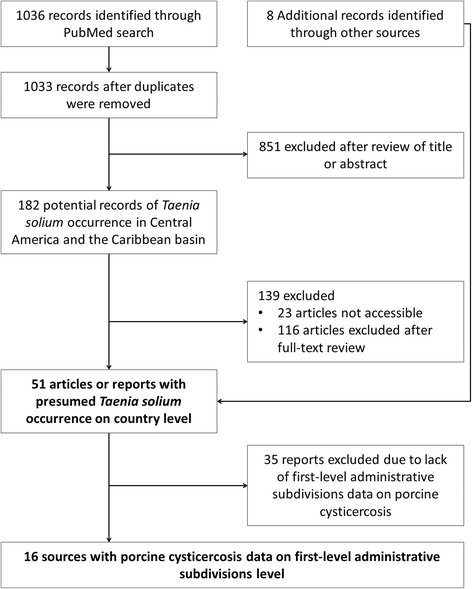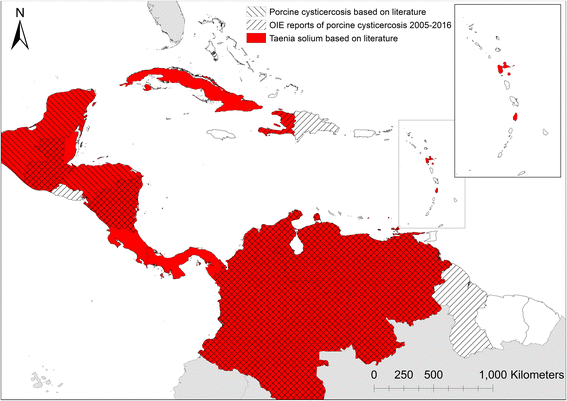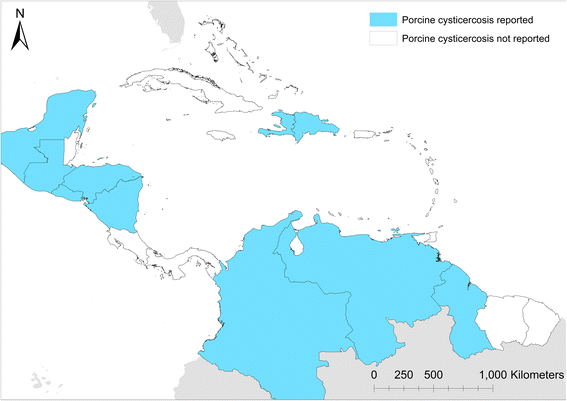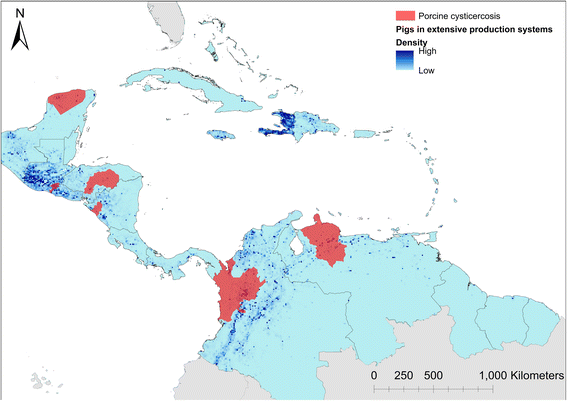Mapping occurrence of Taenia solium taeniosis/cysticercosis and areas at risk of porcine cysticercosis in Central America and the Caribbean basin
- PMID: 28923090
- PMCID: PMC5604492
- DOI: 10.1186/s13071-017-2362-7
Mapping occurrence of Taenia solium taeniosis/cysticercosis and areas at risk of porcine cysticercosis in Central America and the Caribbean basin
Abstract
Background: This study aimed to map the occurrence of Taenia solium taeniosis/cysticercosis at national level within Central America and the Caribbean basin, and to map the distribution of porcine cysticercosis at first-level administrative subdivision level (department level) and the porcine population at risk. This zoonotic parasite is believed to be widely endemic across most of Latin America. However, there is little information readily available for Central America and the Caribbean basin. Taenia solium has been ranked the most important foodborne parasitic hazard globally and within endemic areas is a common cause of preventable epilepsy.
Methods: We conducted a structured literature search in PubMed, supplemented and crossed-referenced with relevant academic databases, grey literature, and active searches in identified literature, to identify all records of T. solium presence in Central America and the Caribbean basin between 1986 and April 2017. To retrieve grey literature, government entities, researchers and relevant institutions across the region were contacted in an attempt to cover all countries and territories. Identified records containing data on porcine cysticercosis were geo-referenced to identify department level distribution and compared to modelled distributions of pigs reared under extensive production systems.
Results: We identified 51 records of T. solium at the national level, covering 13 countries and an additional three countries were included based on World Organisation for Animal Health (OIE) reports, giving a total of 16 countries out of 41 with evidence of the parasite's presence. Screening records for porcine cysticercosis data at the departmental level confirmed porcine cysticercosis presence in 11 departments across six countries (Colombia, Guatemala, Honduras, Mexico, Nicaragua and Venezuela).
Conclusions: When comparing these results to areas where pigs were kept in extensive production systems and areas where no information on porcine cysticercosis exists, it is apparent that porcine cysticercosis is likely to be underreported, and that a substantial part of the regional pig population could be at risk of contracting porcine cysticercosis. More detailed information on the distribution of T. solium and accurate burden estimations are urgently needed to grasp the true extent of this zoonotic parasite and the public health and agricultural problems it potentially poses.
Keywords: Distribution; Mapping; Neglected tropical disease; Taenia solium taeniosis/cysticercosis; Tapeworm.
Conflict of interest statement
Ethics approval and consent to participate
Not applicable.
Consent for publication
Not applicable.
Competing interests
The authors declare that they have no competing interests.
Publisher’s Note
Springer Nature remains neutral with regard to jurisdictional claims in published maps and institutional affiliations.
Figures




References
-
- Robinson TP, Thornton PK, Franceschini G, Kruska R, Chiozza F, Notenbaert AMO, et al. Global livestock production systems. Rome: FAO and ILRI; 2011.
-
- Komba EV, Kimbi EC, Ngowi HA, Kimera SI, Mlangwa JE, Lekule FP, et al. Prevalence of porcine cysticercosis and associated risk factors in smallholder pig production systems in Mbeya region, southern highlands of Tanzania. Vet Parasitol. 2013;198(3–4):284–291. doi: 10.1016/j.vetpar.2013.09.020. - DOI - PubMed
-
- WHO . Working to overcome the global impact of neglected tropical diseases: First WHO report on neglected tropical diseases. Geneva: World Health Organization; 2010.
-
- Torgerson PR, Devleesschauwer B, Praet N, Speybroeck N, Willingham AL, Kasuga F, et al. World Health Organization estimates of the global and regional disease burden of 11 foodborne parasitic diseases, 2010: a Data Synthesis. PLoS Med. 2015;12(12):e1001920. doi: 10.1371/journal.pmed.1001920. - DOI - PMC - PubMed
Publication types
MeSH terms
LinkOut - more resources
Full Text Sources
Other Literature Sources
Miscellaneous

